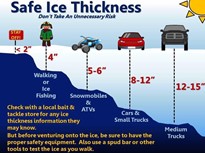Ice Safety And Survival

NO ICE should ever be considered as SAFE ICE. Lifesaving Resources encourages the public to be cautious when fishing, skating, skiing, or snowmobiling on frozen ponds. And, just as important, the public should know what to do and be prepared in the event of an emergency.
Every year, a number of people drown while venturing out onto the ice in an attempt to save their pets that have fallen through the ice. Keep your pets under control and off the ice.
In the event your pet or a person falls through the ice, immediately call or direct someone to call the emergency services and only attempt a shore-based rescue by throwing something or extending something to the victim from the safety of the shore or solid ice.
How Thick Should Ice Be?

Before venturing out onto the ice take the time to assess the thickness, integrity, and consistency of the ice. But, be aware that ice does not freeze evenly across a body of water. The ice might be 4” in one location, but only 2” a short distance away. Moving water, partially or fully submerged objects (i.e. tree branches or rocks), fish and birds, are all going to impact the integrity of the ice.
At least 4” of new, clear and hard ice is required to support a single person for walking, skating, skiing, or ice fishing, and groups require 5” – 6” of new, clear, hard ice.
At least 5” – 6” of new, clear and hard ice is required to support a snowmobile. At least 8” – 12” of new, clear and hard ice is required to support a car or small pick-up truck, and at least 12” – 15” of new, clear and hard ice is required to support a full-sized pick-up truck.
Equipment To Make Walking On Ice Safer
When venturing out onto the ice carry a pea-less plastic whistle that can be used in the event of an emergency to signal others. A pea-less design is preferred as it can get wet and even be fully immersed in water. But, after emptying the water out, it will work effectively.
Also, carry ice picks that can be used to pull yourself out of the water and back onto solid ice in the event of a fall-through.
Consider purchasing and wearing a float-coat or anti-exposure coveralls when out on the ice.
These items are Personal Flotation Devices (PFDs) that are designed to keep you warm and dry when on the ice; and, they provide buoyancy and extended hypothermia protection in the event of a fall-through into the water. A float-coat or anti-exposure coveralls would be especially useful for ice fisherman and snowmobilers.
What To Do If You Fall Through Ice
In the event you fall through the ice, immediately cover your mouth and nose with your gloved hand in order to prevent you from gasping and aspirating cold water into your mouth and airway. Don’t panic! You need to concentrate on getting your breathing under control so you don’t hyperventilate. Just take slow, even, and full breaths.
Do not remove your clothing. Your clothing will actually trap air and will provide you with a degree of buoyancy to help you stay afloat. And, your clothes will help insulate you from the cold water.
It is important that you take immediate and deliberate steps to self-rescue yourself. Turn back in the direction you came from and extricate yourself onto that section of the ice as it was strong enough to support you prior to your fall-through.
Kick your feet out behind you in order to get your body horizontal in the water. Then, continue kicking with your legs and swim up onto the ice. Place your elbows on the ice shelf and let the water drain out of your clothes.
If you have ice picks, use them to pull yourself out onto the ice using short choppy strokes. Do not extend your arm fully as you drive the pick into the ice. Again, just short choppy strokes are needed to pull you out.
If you don’t have picks, then just slowly pull your body up onto the ice shelf with your arms while kicking your feet for propulsion and to keep your body horizontal.
Once out onto the ice, stay horizontal and roll away from the hole until you are on solid enough ice to crawl and then walk away. Once off the ice, seek immediate shelter to dry off and warm up.
The 1-10-1 Rule
We advocate the principle of the 1-10-1 Rule. Upon entering the cold water, you have 1-minute to get your breathing under control. You have 10-minutes of meaningful movement of your arms and legs to perform a self-rescue before your muscles stiffen up from the cold. And, you have 1-hour before losing consciousness due to hypothermia.
Videos On Ice Safety
NBC Segment on Ice Safety
Lifesaving Resources Ice Safety & Rescue
How to Survive a Fall Through Frozen Ice
How to Survive Falling Through Ice


